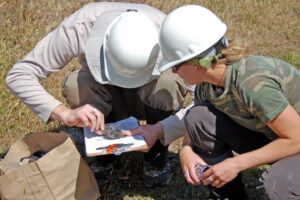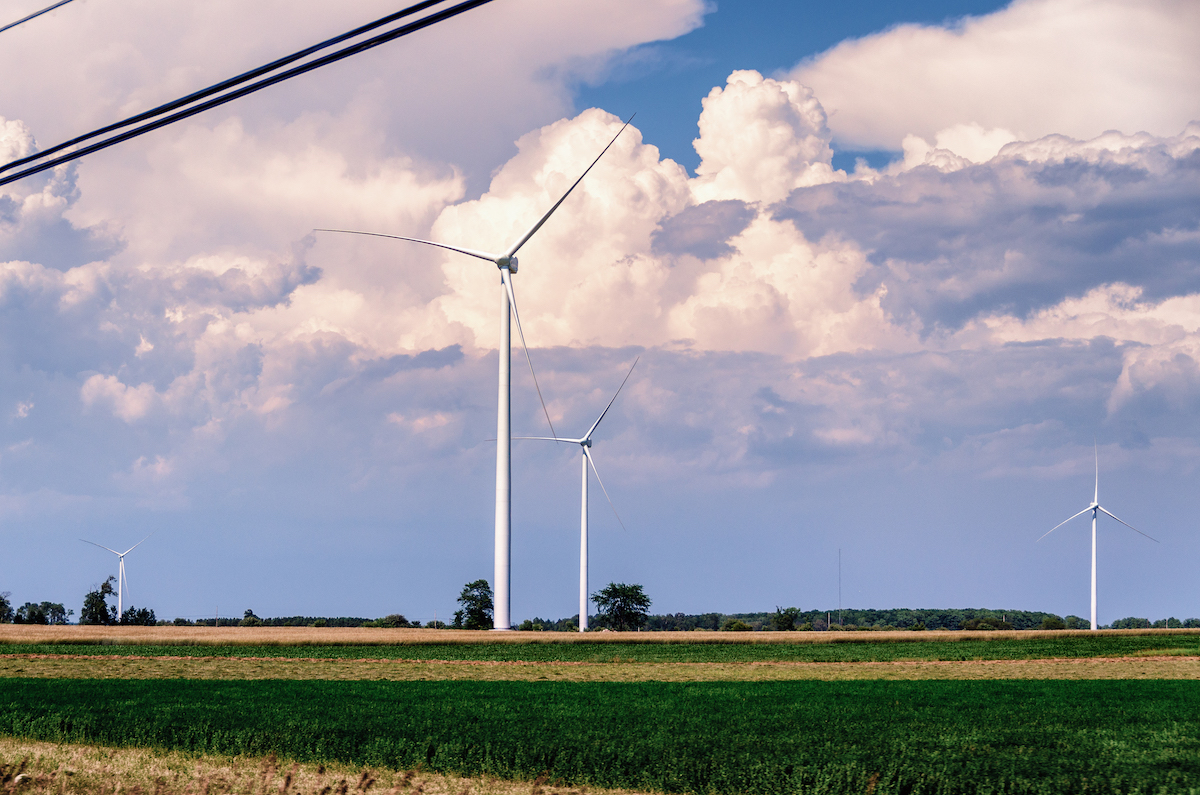If you’ve been a Jack Pine Warbler reader since at least the start of the year, you’ll recall seeing content focused heavily on what’s involved and what’s at stake when it comes to wind energy developments in Michigan.
To take a different angle in telling a feature story for our member magazine, we invited two volunteers to share their conversation in narrative form about the Garden Wind Farm project in the Upper Peninsula. This project was given the green light in 2018 and involved developing a turbine farm for generating energy.
Jared Hocking, a new volunteer and recent graduate from the University of Michigan’s School of Environment and Sustainability, spoke with Joe Kaplan, a long-term volunteer, U.P. resident, birder, and wildlife biologist with historical knowledge and involvement with the project that has been named Garden Wind Farm.
Jared (Q): Today, we’re talking about the Garden Wind Farm project on the Upper Peninsula’s Garden Peninsula. So how did this wind farm project come together? And why is this a special area for birds?

The Garden Wind Farm is located on the Garden Peninsula in Delta County.
Joe (A): There is no question that the Garden Peninsula is one of the more special places for birdwatching in Michigan’s U.P., and it is a prominent migratory flyway on Lake Michigan. Garden Peninsula borders Fayette Historic State Park on the east side, where during the spring migration, you have a flood of migrants with hundreds of warblers and sparrows streaming up or down the peninsula. During the winter migration, you have a great chance of seeing many different majestic birds, perhaps due to the more expansive and diverse open country. You will see Sharp-tailed Grouse, Rough-legged Hawks, and Snow Buntings — even a few Great Gray Owls. Of course, if you drop down to the beach on Lake Michigan, you will see many waterbirds and gulls from American White Pelicans to Sandhill Cranes. You also have numerous offshore islands like Poverty, Summer, and St. Martin that together create an important bridge for migrants to Wisconsin’s Door Peninsula.
Back in 2011, founder and chief executive of Heritage Sustainable Energy, Marty Lagina (who is actually a longtime oil and gas guy who founded a company called Terra Energy Partners), first started thinking about developing a wind farm on the peninsula. Marty had a powerful attorney who knew that given the project’s location, he would likely never be able to satisfy the U.S. Fish and Wildlife Service over the risk to migratory birds — it would go against all the volunteer siting requirements that the USFWS puts out.
But Marty was already committed to that site, and it was a great site for wind energy. So instead of looking for an alternative site, Marty just denied everything. He denied there would be any effects on birds. They had already bought up a bunch of leases in the area, and they proposed they were going to build the project.
Bert Fisher of the USFWS sent a letter (which was also signed by Scott Hicks, the field office supervisor for the Michigan Ecological Services Field Office at the time) to Heritage saying if they did not comply with the Migratory Bird Treaty Act, they would likely be prosecuted for harming migratory birds.
That got Marty’s attention. After some litigation, which was brought by the National Wildlife Federation, Marty promised to do all these studies and mitigation measures and this and that. He built one turbine, and then said to USFWS and NWF, “Let me build 14.” So he built 14 turbines, about 500 feet tall. But with the Garden Wind Farm project and others, Heritage was ignoring the effects to warblers and Piping Plovers, so the USFWS did not authorize the permit. They said in that letter to Heritage that they are liable; they don’t recommend building in those places.
Heritage basically just ignored them and kept saying, “We’re not having any impact [on birds].” Basically, what they’re claiming is plausible deniability. And those 14 turbines are still operating there today.
Q: On the Heritage company website, they have a list of “myths” associated with the project that at one time were thought to be true but have since been proven false. For example, they claim that it’s been proven that a common barnyard cat will have more impact than the entire wind farm. What do you make of that claim? And the others they make?
A: Let’s say it’s unsubstantiated. I mean, it’s interesting because that seems to be the default of the energy companies — they always compare their mortality to something that kills, but I don’t know if this analogy works. That would be like saying that alcoholism kills far more people than heroin, which is an absolutely true statement.
We have to think about what we have the most control over. We can control how many wind turbines we install and how we operate them. We have — I think — less control over the behavior of a barnyard cat.
Q: Another claim that Heritage makes on the site is that they have drawn this conclusion from “independent avian studies,” which have found very little mortality. Have you seen these studies?
A: The first thing I will tell you is that they’re “business confidential.” The wind energy industry, like many other industries, hides behind this label. I tried to get access to them but faced resistance, so I have since backed off.
Q: Let’s talk about the regulatory framework that approves projects like the Garden Wind Farm. How are projects like this authorized?
A: So, one relevant treaty here that dictates permits like this is the Migratory Bird Treaty Act. The MBTA prohibits “taking” a migratory bird, whether intentionally or unintentionally. So how could wind operators operate a farm that has a high likelihood of “taking” — meaning harming, harassing, threatening, or killing — a migratory bird, right?
With the MBTA, the law is written and understood that it doesn’t matter if the “take” is intentional or not intentional (however, that’s what the Trump administration just tried to change). The USFWS cannot authorize a company to take a certain number of migratory birds unless they get a special permit. In most cases they say, “Wink, wink, we are not going to pursue an enforcement action if you follow all the voluntary guidelines.”
In the last few years, there have been changes to the Golden and Bald Eagle Protection Act, which has provisions for take. A company like Heritage could apply for a permit under the act to take eagles. Then, USFWS could do a risk analysis that says, “Over the lifetime of this project, you’re allowed 20 Bald Eagles or 20 Golden Eagles.” They could authorize a permit for that or even for the take of endangered species. But in general, you better have a really good justification for why you’re killing endangered species.
In California right now, there is a [wind] company working on mitigation efforts for condors. Instead of saying that they will protect the ones living free in the wild, the company says, “We’ll spend half a million dollars to [breed more condors to replace] those we kill and make up the difference by charging more in electricity.”
Q: What is wrong with the current framework? Where would you improve?
A: Right now, the question that federal agencies are looking at is what the relative impact of this project is. If the storyline is that cats kill more birds, this pretty much negates the impact [of wind energy] as long as the USFWS buys that ridiculous storyline. There’s no empirical data to support how many birds are killed by a typical barnyard cat.
Secondly, the guidelines developed by USFWS don’t have the force of law. Carrying out studies or doing proper siting is not mandatory, nor is even consulting with the USFWS for a certain-scale energy project. We need to make all that mandatory and by the force of law.
Thirdly, I would change these studies, once they are made mandatory, to be public information and require them to be shared with USFWS on an annual basis, rather than being “business confidential,” as Heritage claims.

Wildlife biologists examine a dead bird found at a wind farm in Altamount County, Calif. Photo by Elizabeth Pepin | Flickr CC
Fourthly, who is carrying out these studies? I am a successful biologist because I get results. But with these wind farms, it’s the opposite — they don’t want to find any results. So when the companies can hire their own firm and call it “independent,” that obviously presents a conflict of interest. They’re not going to hire a biologist who will find a bunch of dead migratory birds.
Another thing we have to look at with regulation is making the use of technology mandatory. For example, the Garden Wind Farm project could use the detection system produced by the FAA where the lights [on turbines] are off completely until a plane or bird comes nearby, which would trigger them to come on.
With this technology, places like the Garden Peninsula would probably be dark at night 95% of the time, addressing a huge aesthetic impact and potential environmental concern with birds. Still, it would have cost Heritage about $600,000 to do it, and of course they didn’t want to do that because they didn’t have to. Heritage would rather spend the money to lobby someone to prevent that from becoming a rule. But what if we had to use such technology? This could be a big part of the answer.
Q: How is the fight for responsible wind energy siting different from previous fights to protect birds from the effects of communication towers and other technologies?
A: To me, in terms of protecting wind turbines, I view them the same as communication towers. I was involved in the original petition to the FCC to get them to recognize the effects of communication towers on birds.
Since that time, there have been all sorts of changes, including requiring lights on towers, but companies are not going back and turning off the lights at the appropriate times.
The companies that operate these types of industrial technologies have savvy legal departments. The departments are likely advising them to position as, “Whoa, our towers don’t kill birds. You can’t tell us that our towers kill birds,” even though every tower kills birds. Carrying out studies is not mandatory, given that these regulations are voluntary.
In the 1970s, when these 1,000-foot towers started going up, they decimated North American bird populations. One country doctor in Clare, Wisc., from the late 1950s, recorded 120,000 dead birds over a few nights at one tower. He had nights where there would be 30,000 dead birds from a single tower. Show me a feral cat that can do that. So what we are doing now is exacerbating modern-day impacts on a resource — endangered, beautiful birds — that we nearly squandered 50 years ago. It’s tragic.
And today, if you were to go to that same tower, you can’t find anywhere close to that level of mortality. It doesn’t exist. Why? Because there are barely any birds anymore. So, unless we want zero birds in the sky, we have to start thinking about how to site these types of industrial technologies better.
Q: Given that we know climate change presents not only an existential threat to humans but also birds and almost every species on the planet, how should we think about the risks posed by wind energy development compared to climate change? Is it possible for us to get to 100% clean energy without wind power? Are large-scale wind farms that might kill birds a necessary evil?
A: Well, one of the first things I would look at is how we can make the economics make sense for every homeowner or property owner in the country to have rooftop solar. If I hadn’t installed my solar panels on my small lakeside cabin, I would be paying almost 2 ½ times the amount that I am paying in Escanaba for kilowatts of electricity. But that’s because I am part of a certain 1%. I am one of the first 1% of customers in the state that qualified for net metering — meaning I am selling the electricity produced back to the grid. Why is that only 1%, though? If, as customers, we are generating electricity and sending it back to the grid, why shouldn’t we get credit? Making those economics make sense could do a lot to mobilize the rooftop solar market.
And, of course, we have to look at responsible siting…and enforce the existing laws. If USFWS isn’t making sure that these huge wind energy projects are not harming migratory birds, then they’re not enforcing the law.
~ by Jared Hocking
Featured photo: Wind turbines in Delta County by Pat Kight | Flickr CC
This article appeared in the 2021 Summer Jack Pine Warbler.
In each issue of the Jack Pine Warbler this year, we will feature a piece connected to alternative energy in Michigan, community science and advocacy, and outreach that can help us protect our peninsulas for birds and people alike.
You can read the previous articles Meeting the Demands for Alternative Energy and Its Impact on Michigan Birds and Wind Energy and Birds in Michigan: The Montcalm Wind Project. Stay tuned for the final piece in the 2021 Fall JPW.



